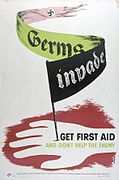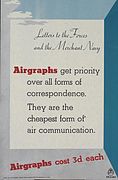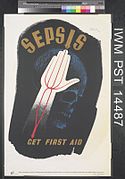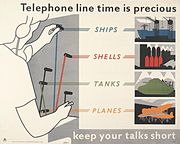Hans Arnold Rothholz
Hans Arnold Rothholz (1919–2000) was a poster designer and graphic artist born in Dresden, Germany who immigrated to Britain in 1933. As a friend and colleague of Tom Eckersley, George Him and Abram Games, Rothholz belonged to a generation of designers who transformed visual communication in Britain.[1]
Rothholz's posters are featured in many public collections, including the Imperial War Museum, the Victoria and Albert Museum and the London Transport Museum,[2] and his archive is located at University of Brighton Design Archives.[3]
Education[]
Rothholz began his artistic training at Willesden School of Art, then studied commercial art and display design at the Reimann School, London (1938-9) - a successor of the renowned Reimann Schule in Berlin. He was one of the few students to receive the Reimann School Diploma.[4]
Career[]
1940s[]
During the Second World War Rothholz was interned in Canada, Liverpool, and on the Isle of Man,[5] however he returned to London in 1942 where he established a successful career as a graphic and information designer.
Rothholz designed posters for various clients, including the Post Office[6] and the Royal Society for the Prevention of Accidents (RoSPA).[7] He also designed promotional material for Wembley Stadium which included the 1948 Olympic Games.
1950s[]
In 1951 Rothholz was commissioned to work on the Land Travelling Exhibition as part of the Festival of Britain. He also designed film posters for Ealing Studios.[8]
Rothholz's other clients from the 1950s included BEA, BOAC, Perera, Lyons & Co and Splendida. Rothholz also designed the programme for the 1957 World Scout Jamboree.
1960s[]
Rothholz designed graphic schemes and murals for the Bacon & Egg and Grill & Cheese restaurant chains.[9] Throughout the 1960s, Rothholz re-branded Winsor & Newton art materials, and towards the end of the decade, he created a new corporate identity for Wellcome, including packaging, vehicle liveries and stationery.[10]
In 1961 Rothholz was asked to design the Society of Industrial Artists' (SIA) showcase exhibition The Art of Persuasion, and was elected a Fellow of the Society of Industrial Artists in 1962. He also served on the SIA’s Council.[2]
Post-humous[]
In 2006, British clothing designer Margaret Howell exhibited a collection of Rothholz's posters at her flagship Wigmore Street store,[11] and in 2007 produced a calendar of his poster designs.
BFI Southbank displayed a selection of original posters, photographs and press material from Ealing Studios in 2012, including Rothholz's poster for They Came to a City (1945).[12]
Gallery[]

A hand injured by a wooden stick which is also a pole bearin Wellcome L0026443

Get First Aid Quickly (recto) wrong - Right (verso) Art.IWMPST14495

Letters to the Forces and the Merchant Navy Art.IWMPST10029

Sepsis (recto) cut 'em Short (verso) Art.IWMPST14487

Telephone Line Time is Precious Art.IWMPST4037
References[]
- ^ Brief biography and examples of work
- ^ Jump up to: a b Breakell, Sue and Whitworth, Lesley, "Émigré Designers in the University of Brighton Design Archives", Journal of Design History, 2013
- ^ HA Rothholz Archive, University of Brighton Design Archives
- ^ Suga, Yasuko, The Reimann School, Artmonsky Arts, 2013, ISBN 978-0-9573875-3-9
- ^ Artist biography- Hans Arnold Rothholz, London Transport Museum
- ^ The British Postal Museum and Archive
- ^ World War 2 Posters - RoSPA website
- ^ Article on BFI website
- ^ No Room For Horse Play Here - examples of Rothholz's work
- ^ Poster Subject Specialist Network 2013
- ^ Review of H. A. Rothholz exhibition
- ^ "Ealing Studios: Posters Galore - in Pictures" The Guardian 16 October 2012
Further reading[]
- Lawrence, David, A Logo For London, Laurence King Publishing, 2013, ISBN 978-1-78067-296-0
- Moore, Colin, Propaganda Prints: A History of Art in the Service of Social and Political Change, A&C Black Publishers, 2010, ISBN 978-140-81-0591-7
- Rennie, Paul, Design: GPO Posters, Antique Collector's Club, 2010, ISBN 978-1-85149-596-2
External links[]
- HA (Arnold) Rothholz, graphic designer, feature on the Archives Hub
- Imperial War Museum: Posters of Conflict, online visual database
- German graphic designers
- 1919 births
- German poster artists
- 2000 deaths
- Alumni of Reimann School (London)




